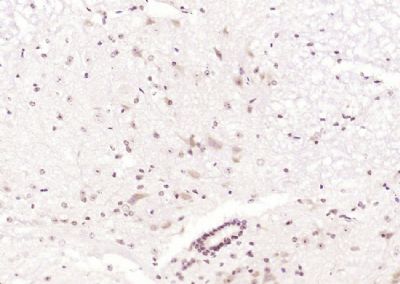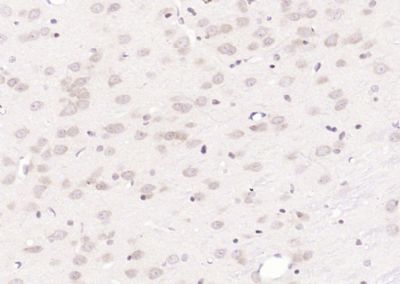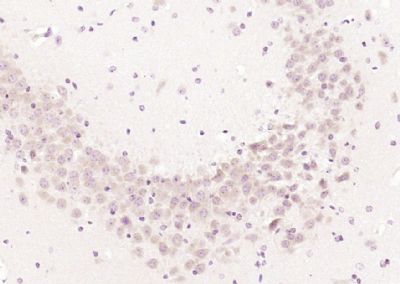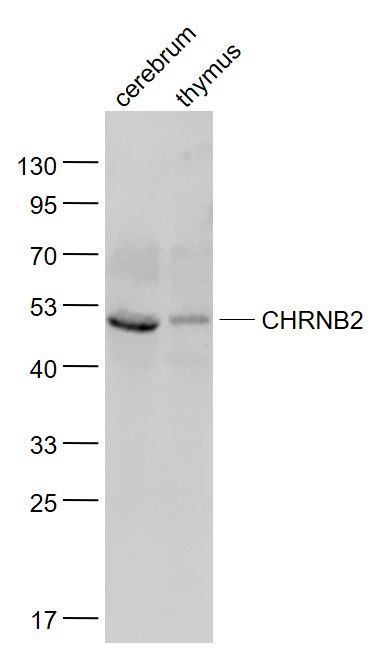CHRNB2 Polyclonal Antibody
Purified Rabbit Polyclonal Antibody (Pab)
- SPECIFICATION
- CITATIONS
- PROTOCOLS
- BACKGROUND

Application
| WB, IHC-P, IHC-F, IF, ICC |
|---|---|
| Primary Accession | Q9ERK7 |
| Reactivity | Rat |
| Host | Rabbit |
| Clonality | Polyclonal |
| Calculated MW | 52 KDa |
| Physical State | Liquid |
| Immunogen | KLH conjugated synthetic peptide derived from mouse CHRNB2 |
| Isotype | IgG |
| Purity | affinity purified by Protein A |
| Buffer | 0.01M TBS (pH7.4) with 1% BSA, 0.02% Proclin300 and 50% Glycerol. |
| SUBCELLULAR LOCATION | Cell junction, synapse, postsynaptic cell membrane; Multi-pass membrane protein. Cell membrane; Multi-pass membrane protein. |
| SIMILARITY | Belongs to the ligand-gated ion channel (TC 1.A.9) family. Acetylcholine receptor (TC 1.A.9.1) subfamily. Beta-2/CHRNB2 sub-subfamily. |
| SUBUNIT | Neuronal AChR is composed of two different types of subunits: alpha and beta. Beta-2 subunit can be combined to alpha-2, alpha-3 or alpha-4 to give rise to functional receptors. Interacts with RIC3; which is required for proper folding and assembly. |
| Important Note | This product as supplied is intended for research use only, not for use in human, therapeutic or diagnostic applications. |
| Background Descriptions | Neuronal acetylcholine receptors are homo- or heteropentameric complexes composed of homologous alpha and beta subunits. They belong to a superfamily of ligand-gated ion channels which allow the flow of sodium and potassium across the plasma membrane in response to ligands such as acetylcholine and nicotine. This gene encodes one of several beta subunits. Mutations in this gene are associated with autosomal dominant nocturnal frontal lobe epilepsy. [provided by RefSeq, Jul 2008] |
| Gene ID | 11444 |
|---|---|
| Other Names | Neuronal acetylcholine receptor subunit beta-2, Chrnb2 |
| Dilution | WB=1:500-2000,IHC-P=1:100-500,IHC-F=1:100-500,ICC=1:100-500,IF=1:100-500 |
| Storage | Store at -20 ℃ for one year. Avoid repeated freeze/thaw cycles. When reconstituted in sterile pH 7.4 0.01M PBS or diluent of antibody the antibody is stable for at least two weeks at 2-4 ℃. |
| Name | Chrnb2 |
|---|---|
| Function | Component of neuronal acetylcholine receptors (nAChRs) that function as pentameric, ligand-gated cation channels with high calcium permeability among other activities. nAChRs are excitatory neurotrasnmitter receptors formed by a collection of nAChR subunits known to mediate synaptic transmission in the nervous system and the neuromuscular junction. Each nAchR subunit confers differential attributes to channel properties, including activation, deactivation and desensitization kinetics, pH sensitivity, cation permeability, and binding to allosteric modulators. CHRNB2 forms heteropentameric neuronal acetylcholine receptors with CHRNA2, CHRNA3, CHRNA4 and CHRNA6, as well as CHRNA5 and CHRNB3 as accesory subunits. Found in two major stoichiometric forms,(CHRNA4)3:(CHRNB2)2 and (CHRNA4)2:(CHRNB2)3, the two stoichiometric forms differ in their unitary conductance, calcium permeability, ACh sensitivity and potentiation by divalent cation (By similarity). Heteropentameric channels with CHRNA6 and CHRNA4 exhibit high sensitivity to ACh and nicotine and are predominantly expressed in only a few brain areas, including dopaminergic neurons, norepirephrine neurons and cells of the visual system. nAChrs containing CHRNA6 subunits mediate endogenous cholinergic modulation of dopamine and gamma-aminobutyric acid (GABA) release in response to nicotine at nerve terminals (By similarity). Also forms functional nAChRs with other subunits such as CHRNA7:CHRNB2, mainly expressed in basal forebrain cholinergic neurons (By similarity). |
| Cellular Location | Synaptic cell membrane {ECO:0000250|UniProtKB:P12390}; Multi-pass membrane protein. Cell membrane {ECO:0000250|UniProtKB:P17787}; Multi-pass membrane protein |

Thousands of laboratories across the world have published research that depended on the performance of antibodies from Abcepta to advance their research. Check out links to articles that cite our products in major peer-reviewed journals, organized by research category.
info@abcepta.com, and receive a free "I Love Antibodies" mug.
Provided below are standard protocols that you may find useful for product applications.
If you have used an Abcepta product and would like to share how it has performed, please click on the "Submit Review" button and provide the requested information. Our staff will examine and post your review and contact you if needed.
If you have any additional inquiries please email technical services at tech@abcepta.com.













 Foundational characteristics of cancer include proliferation, angiogenesis, migration, evasion of apoptosis, and cellular immortality. Find key markers for these cellular processes and antibodies to detect them.
Foundational characteristics of cancer include proliferation, angiogenesis, migration, evasion of apoptosis, and cellular immortality. Find key markers for these cellular processes and antibodies to detect them. The SUMOplot™ Analysis Program predicts and scores sumoylation sites in your protein. SUMOylation is a post-translational modification involved in various cellular processes, such as nuclear-cytosolic transport, transcriptional regulation, apoptosis, protein stability, response to stress, and progression through the cell cycle.
The SUMOplot™ Analysis Program predicts and scores sumoylation sites in your protein. SUMOylation is a post-translational modification involved in various cellular processes, such as nuclear-cytosolic transport, transcriptional regulation, apoptosis, protein stability, response to stress, and progression through the cell cycle. The Autophagy Receptor Motif Plotter predicts and scores autophagy receptor binding sites in your protein. Identifying proteins connected to this pathway is critical to understanding the role of autophagy in physiological as well as pathological processes such as development, differentiation, neurodegenerative diseases, stress, infection, and cancer.
The Autophagy Receptor Motif Plotter predicts and scores autophagy receptor binding sites in your protein. Identifying proteins connected to this pathway is critical to understanding the role of autophagy in physiological as well as pathological processes such as development, differentiation, neurodegenerative diseases, stress, infection, and cancer.






